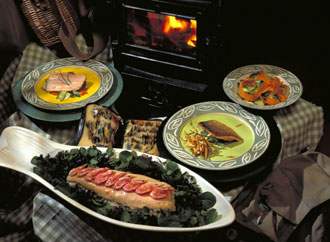 Scottish Breakfast
Scottish Breakfast
In many hotels and B&Bs you'll be offered a Scottish breakfast, similar to its English counterpart of sausage, bacon and egg, but typically with the addition of local favourites such as black pudding (blood sausage) and potato scones. Porridge is another likely option, properly made with oatmeal and water and cooked with salt; it's traditional to add a little milk, though some folk like to sprinkle on some sugar as well. You may also be offered strongly flavoured kippers (hot smoked herring) or more delicate "Arbroath smokies" (smoked haddock). Oatcakes (plain, slightly salty oatmeal biscuits) and a "buttery" butter-enriched bread related to the French croissant and popular in the north of Scotland - might feature.
Fish
Scottish fish and shellfish is the envy of Europe, with a vast array of different types of fish, prawns, lobster, mussels, oysters, crab and scallops found round the extensive Scottish coastline. Fresh fish is normally available in most coastal towns, as well as the big cities, where restaurants have well-organized supply lines. Elaborate dishes are sometimes concocted, though frankly the best seafood dishes are frequently the simplest.
The prevalence of fish farming, now a significant industry in the Highlands and Islands, means that the once-treasured salmon is widespread and relatively inexpensive - its pale pink flesh is still delicious, though those concerned about the environment make sure to search out organic salmon, and connoisseurs keep an eye out for the more delicately flavoured (and more expensive) wild salmon. Both salmon and trout, another commonly farmed fish, are frequently smoked and served cold with bread and butter. Herring, once the staple fish in Scotland, is still popular in some parts fried in oatmeal or "soused" (pickled).
Scottish Beef
The Aberdeen-Angus breed of beef cattle is now widely reared across the world. Reknown for their rich and tasty meat, which makes excellent steaks. Good butchers will still hang and prepare meat in the traditional manner, although these butchers are rare these days and people often complain that even Scotch Beef has lost its taste.
Game
Venison, the meat of the red deer, also features large - low in cholesterol and very tasty, it's served roasted or in casseroles, often cooked with juniper and red wine.
If you like game and can afford it, splash out on grouse, the most highly prized of all game birds, which when cooked properly is strong, dark and succulent. Pheasant is also worth a try and is less rich than other game, more like a tasty chicken; you can eat it stuffed with oatmeal or with a mealie pudding, a kind of vegetarian black pudding made from onion, oatmeal and spices.
Haggis
The quintessential Scots dish is haggis, a type of rich sausage meat made from spiced liver, offal, oatmeal and onion and cooked inside a bag made from a sheep's stomach. Though more frequently found on tourist-oriented menus than the dining tables of Scots at home, it's traditionally eaten with "bashed neeps" (mashed turnips) and "chappit tatties" (mashed potatoes). The humble haggis has become rather trendy in recent years, appearing in swanky restaurants wrapped in filo pastry or drizzled with berry sauce, and a vegetarian version is widely available.
Scotch Broth or Hotch-Potch
A rich stock is traditionally made by boiling mutton (the neck is best), beef, marrow-bone or chicken (for a chicken broth). There is also freedom over the choice of vegetables, which should be diced. Carrots, garden peas, leeks, cabbage, turnips and a stick of celery can all be used. The hard vegetables should be added first to the boiling stock, with a handful of barley, with the softer vegetables being added later. The final consistency should be thick and served piping hot.
Cheese
Another local product to enjoy an upsurge in popularity recently is cheese, which you'll find in a number of specialist shops and delis, while many classier restaurants making a point of serving only Scottish cheeses after dinner. The types on offer cover a wide spectrum: look out in particular for Isle of Mull, a tangy farmhouse cheddar; Dunsyre Blue, a Scottish Dolcelatte; and Howgate, a Camembert made near St Andrews. A craft skill once practised widely both in Highland and Lowland Scotland, the enthusiasm for natural, genuine and traditional foods has meant a revival in small-scale artisan and farmhouse cheese making.
点击查看本频道更多精彩内容